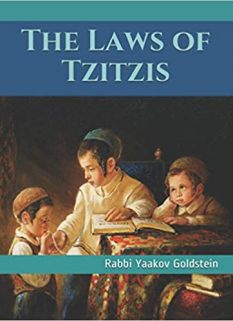*The article below is an excerpt from the above Sefer
*As an Amazon Associate I earn from qualifying purchases.
- The Talmudic statement: The Talmud states that if one sees that his friend has sinned, then it is a Mitzvah to hate him and also tell his teacher to hate him. [This seemingly contradicts the above command to love every single Jew.]
- Only applies to an observant Jew: [To answer the above seeming contradiction, we must first establish as to which type of Jew the above applies to.] The above Talmudic statement is only directed towards a transgressor who is observant of Torah and Mitzvos [and not towards an individual who is not observant].
- Only applies if you already reproved him: Furthermore, even by an observant Jew who has sinned, the instruction to hate him only applies if one already fulfilled the Mitzvah to rebuke him and he nonetheless refuses to repent.
(LY) 27th Adar 1
- Only applies if one is acquainted and on intimate terms with the individual: Based on the above, we can deduce that one who is not acquainted with the transgressor and is not his friend and is not on intimate terms with him, then the above instruction and Mitzvah to hate him does not apply.
- The Mitzvah to love all creatures: [Furthermore, not only may one not hate an individual who is not his colleague in Torah and Mitzvah’s and is excluded from the above instruction to be hated, but] on the contrary, towards such a person applies the dictum of Hillel the Elder that one should always chase after peace, and love all creatures and draw them closer to Torah.
- The Mitzvah to love nonreligious Jews and bring them back to Judaism with love: The above instruction to love all creatures includes even those who are very distanced from the Torah and service of G-d, and are hence referred to as mere creatures, nonetheless, one is instructed to attract them to Judaism with strong cords of love.
- The purpose of this love to the nonreligious Jew-Fulfills the Mitzvah of Ahavas Yisrael: [There are no drawbacks involved in this love for the nonreligious Jew, as] if he is successful, then he will manage to bring him back to Torah and service of G-d, and even if he is not successful, he does not lose out from being rewarded for fulfilling the Mitzvah of loving his fellow Jew.
(LY) 28th Adar 1
- Furthermore, even those sinners whom one is instructed to hate being that one has an intimate relationship with them, and he has reproved them, and they have still not repented from their ways, nonetheless, there still remains a Mitzvah to also love them.
- Loving the good and hating the evil: Both the command to hate this Jew and the command to love this Jew are true and viable to be fulfilled, as the hatred is only towards the evil that is within him, while the love is towards his good aspects that are hidden within him, which refers to the G-dly spark that enlivens his G-dly soul.
- Arousing mercy for the sinner: Furthermore, one should also arouse mercy in his heart for the G-dly soul which is found in a state of exile inside of the evil of the transgressor.
- Mercy has ability to nullify the hatred: This mercy that one arouses, has the ability to nullify the hatred towards this Jew and arouse love for him, as is known from the verse “and Jacob [i.e. compassion] which has redeemed Abraham [i.e. love].”
- An exception to all the above is with regards to those who are Halachically defined as heretics, towards whom one is instructed to hate them to the utmost [without any feeling of love or mercy for them].
- The reason for this is because [they have lost all their good and] no longer have a portion in the G-d of Israel.
Related Articles
Daily Tanya Sunday 16th Menachem Av Igeres Hakodesh 5 Part 2: Divine Speech in Creation
Post Views: 46 16th Av The Creation of the World The sages ask why this world was specifically created with the letter Hei (ה). The answer lies in the layered complexity and purposefulness of creation. Multiplicity of Worlds and Spiritual Beings There are countless worlds, palaces, and spiritual beings—angels and
Daily Tanya Tuesday 11th Menachem Av Igeres Hakodesh 4 Part 2: Spiritual Circumcision and Redemption
Post Views: 71 11th Av Divine and Human Roles in Spiritual Transformation An awakening from above only comes in response to an awakening from below; individuals must first initiate the process of spiritual refinement, much like the symbolic act of the “feminine waters” rising before the “masculine waters” descend. Removing
Daily Tanya Monday 10th Menachem Av Igeres Hakodesh 4: The Exile of the Heart and the Path to Redemption
Post Views: 81 The Challenge of Inner Service Not everyone attains deep, heartfelt service to the Divine, as the soul’s inner spiritual faculty can be in a state of exile. The Spiritual Exile This exile mirrors the Shechinah’s exile with the Jewish people, as described by the sages, when the
Daily Tanya Thursday 6th Menachem Av Igeres Hakodesh 2: The Danger of Pride in Receiving Kindness
Post Views: 132 Epistle 2: The Danger of Pride in Receiving Kindness 6th Av Responding to Divine Favors with Humility With every favor bestowed by G-d, a person should become more humble. Being brought closer to G-d requires ever-greater self-effacement, reflecting the principle that “all that are before Him are
Daily Tanya Wednesday 5th Menachem Av Igeres Hakodesh 1 Part 3: Accountability for Prayer Diligence
Post Views: 173 Who Should Lead Prayer on Weekdays During weekdays, those who have free time, such as teachers or individuals supported by their families, should serve as prayer leaders. Businesspeople, who typically lack the time, are generally exempt from this responsibility during the week. The one who leads prayer
Daily Tanya Tuesday 4th Menachem Av Igeres Hakodesh 1 Part 2: The Power and Purpose of Torah Study
Post Views: 187 The Foundation of Faith and Spiritual Strength Faith acts as the support for the intellectual and emotional faculties of the soul, enabling deep contemplation and emotional connection with the Divine. The study of the laws in the Oral Torah is essential, as it reveals the Supreme Divine


 Donate
Donate
Leave A Comment?
You must be logged in to post a comment.